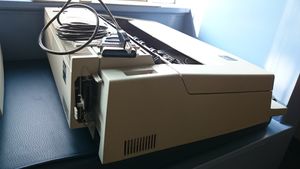IBM Wheelwriter
- More info can be found at the Trello board as we migrate knowledge into this wiki.
- UPDATE: Thankfully tofergregg created an IBM Wheelwriter 3/6 compatible PC Printer Option using an Arduino without even having one, so anyone can use this typewriter as a USB Printer. All you need is an Arduino Nano and some basic electronic components, which can even just be on a breadboard if you're not a soldering nut. It even allows you to use Markdown for the markup of basic bolds and underlines and such things. Unfortunately, we have yet to see something similar for the other Wheelwriter models.
The IBM/Lexmark Wheelwriter series are the last great typewriters. Their electronic buckling spring keyboards (akin to the IBM Model M) are designed to recall the mechanical feel of the IBM Selectric. It has word erasure, and word processing capabilities; more expensive models have page reprint, form filling and floppy storage capabilities. Others have handy LCD displays, and the 5000 series even has VGA monitor output!
Their relatively minimal mechanical parts make them durable and usable to this day. Their word processing capability, character correction, and reprint features make them more accessible to modern typists.
IBM Wheelwriters are generally incredibly cheap at liquidation stores (since they are in low demand), but surprisingly expensive on eBay ($100-300) and elsewhere ($500-1000) due to shipping and markup for a specific (rich federal/lawyer) audience. It's for hardcore collectors only; or lucky laymen.
You can buy your own reconditioned models (for hundreds of dollars!) at Heaster and Lawson or from Batchelor Business Machines. Extra ribbons and correction tape are extremely common and dirt cheap, at $8 apiece.
Sections[edit]
- Tips and Tricks - Miscellaneous tips and tricks that can be done.
- Options - The IBM Wheelwriter was capable of a whole host of optional accessories.
- PC Printer Option - The most important option was an Parallel interface for printing from a PC, effectively transforming the Wheelwriter into a daisywheel printer. Unfortunately, it was also expensive at the time, and remains rare to this day. UPDATE: Thankfully tofergregg created an IBM Wheelwriter 3/6 compatible PC Printer Option using an Arduino without even having one. All you need is an Arduino Nano and some basic electronic components, which can even just be on a breadboard if you're not a soldering nut.
- Packing - If you plan to mail or move your IBM Wheelwriter, make sure to use a lot of bubble wrap and package it carefully.
- Teletype - A teletype can be constructed out of the Wheelwriter in one of two ways: controlling the keyboard, or controlling the PC Printer Option.
- Sources - Sources of knowledge preserved over the ages, and integrated into this wiki.
Models[edit]
There are generally three different case shapes for the IBM Wheelwriter:
- Large (IBM) - The first models were made in a large case with the logic boards in the back of the case, as well as option cards clipped on the back. They also had very weak plastic hinges which tended to break off over time.
- Large (Lexmark) - Around the time IBM spun off the printing division into Lexmark, the Wheelwriters acquired a new shape. These used a significantly reduced mainboard, and option cards were mounted inside the cases. The case hinge was significantly improved as well, as it is a fundamental part of the case molding.
- Personal - IBM introduced an "Actionwriter" series that had a smaller case size. Eventually, it was renamed the Personal Wheelwriter, and then the Wheelwriter 1000 under Lexmark.
IBM Early Wheelwriter[edit]
The first Wheelwriter to come out. Later revisions made incremental upgrades, but the original still makes a great typewriter on the cheap.
- IBM Wheelwriter/5 - This wheelwriter has a much noisier buckling spring keyboard, which is somewhat muffled by attached rubber O-rings on the barrels.
IBM Series I[edit]
The Series I typewriters have the same casing as the first Wheelwriters, but have somewhat different internal circuitry, requiring different Option Cards. They also add full cursor keys.
IBM/Lexmark Series II[edit]
These final models were made in the 90's, and have significantly improved case design, as well as simpler electrical circuitry and more interesting option cards.
The 4 digit models came around the time IBM spun off its printing division into Lexmark, so they were dual branded with IBM and Lexmark logos.
Personal Size[edit]
Some Wheelwriters are somewhat more compact and lighter than the usual large models.
